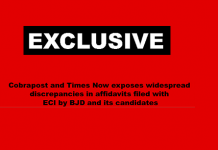In a “fairly disastrous” leak, as termed by one retired Indian naval officer, the “secret combat capability” of the six Scorpene submarines France is supplying to India have been put out on the open on interenet and the secret comprises 22,000 pages.
The leak of sensitive information – first reported by The Australian on Wednesday – could “provide an intelligence bonanza if obtained by India’s strategic rivals, such as Pakistan or China,” the newspaper wrote.
India has contracted to purchase six Scorpene-class submarines from the French company DCNS Group at a cost $3 billion, the first of which is already undergoing sea trials. A second is currently being assembled with French help at the Mazagon docks in Mumbai, following which four more will be produced and commissioned.
Vice-Admiral A.K. Singh (retired) told The Wire on Wednesday that the documents were “no doubt being closely studied in Islamabad and Beijing … I reckon this has saved the Chinese and Pakistanis 20-30 years of espionage.”
However, Admiral Arun Prakash (Retd.), a former Indian naval chief told The Wire that it was too early to jump to any alarmist conclusions about the consequences of the leak.
“If you see the documents that have been put out, they are stamped ‘restricted’,” he said. “Now, at least in the Indian system, restricted is one step away from ‘unclassified’. The highest security classification is ‘Top Secret’, after which there is ‘Secret’ and then ‘Classified’. So it is not clear how sensitive this information is, though the fact that it has leaked is obviously disturbing.”
Though some of the pages have the Indian navy’s emblem, the leak is believed to have occurred at the company level in France. Admiral Prakash said it would be quite natural for the documentation printed by the supplier to use the naval emblem since the submarines were being produced for the Indian navy.
Singh said that though the document is indeed marked ‘Restricted’, it is not clear whose classification this is. “Assuming the documents have leaked from the company, as The Autralian has reported, then this is the company’s own classification,” he said, adding that it is rare for private sector firms to use classifications such as ‘Secret’ or ‘Top Secret’.
According to The Australian,
“The leaked DCNS data details the secret stealth capabilities of the six new Indian submarines, including what frequencies they gather intelligence at, what levels of noise they make at various speeds and their diving depths, range and endurance — all sensitive information that is highly classified. The data tells the submarine crew where on the boat they can speak safely to avoid detection by the enemy. It also discloses magnetic, electromagnetic and infra-red data as well as the specifications of the submarine’s torpedo launch system and the combat system.”
Most of the data leaked is all design related, especially pertaining to sensors and command management, and India will not be in a position to change those parameters in response to the leak without embarking on design changes that will cost of hundreds of millions of dollars, said Singh. “Perhaps only the radiated noise details could be altered, though these have not been tested yet because the monsoons affect the sea trial.”
“As a serious matter pertaining to the Indian Scorpene programme, French national authorities for defence security will formally investigate and determine the exact nature of the leaked documents,” a DCNS spokeswoman said in a statement.
Though the leak concerns the Indian Navy, the issue is considered important in Australia because the DCNS Group beat out Germany’s ThyssenKrupp AG and a Japanese-government backed bid by Mitsubishi Heavy Industries and Kawasaki Heavy Industries to win a A$50 billion ($38.06 billion) contract to build Australia’s next generation of submarines.
“The matters in connection to India have no bearing on the Australian submarine programme which operates under the Australian government’s arrangements for the protection of sensitive data,” DCNS was quoted by Reuters as saying.
The breadth of detail in the documents creates a major strategic problem for India, Malaysia and Chile, all of which operate the same submarine, an Australian political source with decades of experience in the global arms industry told Reuters.
The Australian published the documents in redacted form on the it’s website but the papers included sensitive details of the submarine including technical manuals and models of the boat’s antennae, Reuters reported.
“If it’s 22,400 pages, it’s a major stuff-up,” the news agency quoted a defence expert as saying. “It’s a huge deal.
“It allows them to understand everything about the submarines. What speeds it can do; how noisy it is; what speeds the mast can be raised at … all of that is just devastating.”
The assumption among Indian naval officers is that the information has been leaked as part of the cut-throat competition between rival submarine manufacturers.
Sourced from The Wire, Featured image courtesy:



























